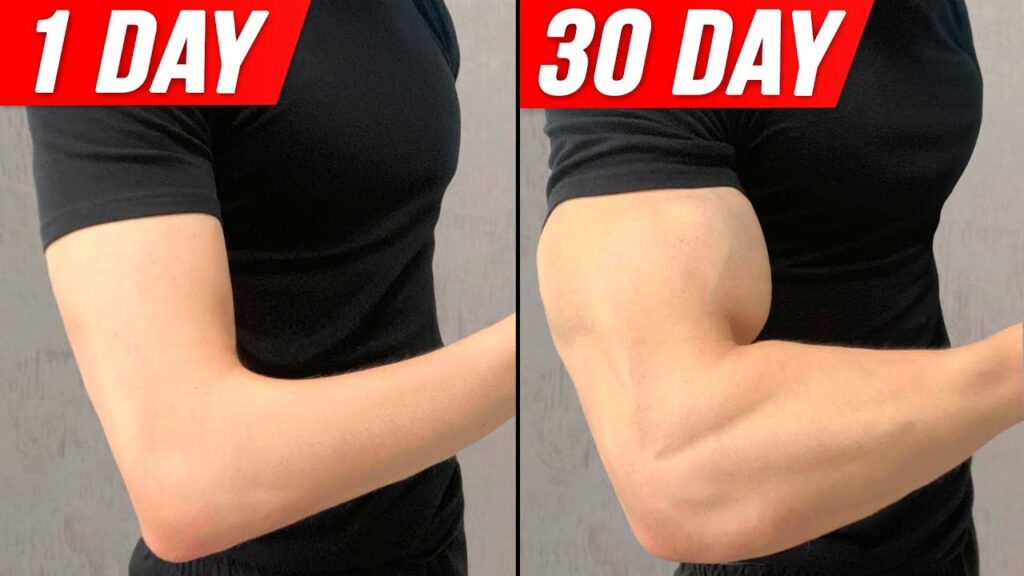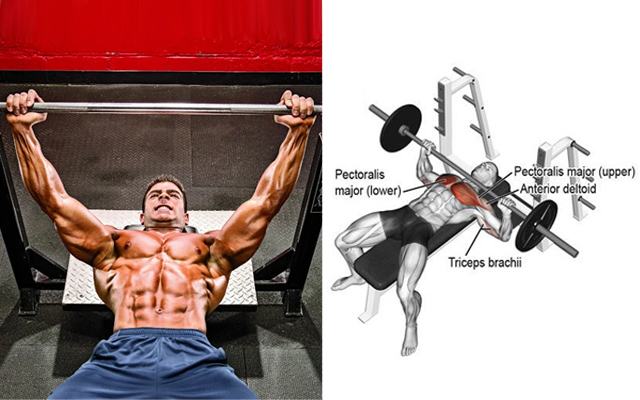Push-ups are one of the most popular and versatile exercises in the fitness world. They are celebrated for their ability to strengthen the chest, triceps, and shoulders while also engaging the core. However, there’s a lingering question that often arises among fitness enthusiasts: Do push-ups work the biceps?
Many people associate push-ups primarily with chest and triceps development, often overlooking the role that other muscles play during this compound movement. The biceps, typically targeted through exercises like curls, might not seem like the obvious beneficiaries of push-ups. Yet, understanding the intricacies of how our muscles work together can reveal some surprising truths.
In this article, we’ll dive deep into the anatomy of a push-up, explore how different muscle groups are engaged, and specifically focus on the biceps. We’ll discuss variations of push-ups that can maximize bicep activation, compare the effectiveness of push-ups to traditional bicep exercises, and provide practical tips to help you incorporate this knowledge into your workout routine.
Biomechanics of Push-ups
The biomechanics of push-ups are fascinating, as they involve a complex interplay of muscles and joints working together to execute the movement. Here’s an overview of what happens in your body during a push-up:
- Muscle Engagement: The primary muscles involved in a push-up are the pectoralis major, triceps brachii, and anterior deltoids. These muscles work together to control the descent (eccentric phase) and push the body back up (concentric phase).
- Joint Movement: Push-ups are a closed kinetic chain exercise, meaning multiple joints are engaged simultaneously. The glenohumeral (shoulder), radiohumeral (elbow), and ulnohumeral (also elbow) joints move in coordination during the push-up.
- Eccentric and Concentric Phases: During the lowering phase, or eccentric contraction, the muscles lengthen under tension. As you push back up, the concentric phase, the muscles shorten to lift your body weight.
- Stabilization: Secondary muscles like the serratus anterior, rectus abdominis, obliques, and transverse abdominis provide stabilization to the core and shoulder girdle, ensuring proper form and preventing injury.
- Kinetic Chain: The push-up is a full-body exercise that requires the stiffening of the knee joints, hip joints, pelvis, and spine to maintain a straight line from head to feet.
- Scapular Motion: The scapulae (shoulder blades) retract and protract to facilitate the range of motion in the shoulders, which is crucial for the effectiveness of the push-up.
Exercise Ideas for Office Workers
Understanding these biomechanical principles can help in performing push-ups more effectively and safely, maximizing the benefits of the exercise while minimizing the risk of injury. It’s also essential for those looking to engage their biceps more during push-ups, as slight modifications in hand placement and body angle can shift the focus to different muscle groups.
Variations of Push-Ups for Biceps Activation
While traditional push-ups are not known for targeting the biceps primarily, several variations can alter the muscle engagement to include the biceps more effectively. Here are some push-up variations that can help engage and work the biceps:
1. Close-Grip Push-Ups (Diamond Push-Ups)

How to Perform:
- Start in a standard push-up position.
- Bring your hands closer together so that your thumbs and index fingers form a diamond shape.
- Lower your body while keeping your elbows tucked close to your sides.
- Push back up to the starting position.
Why It Works:
- The close-hand position shifts more of the load onto your triceps and biceps, enhancing their activation.
2. Reverse Grip Push-Ups

How to Perform:
- Begin in a standard push-up position, but rotate your hands so that your fingers point towards your feet.
- Ensure your hands are shoulder-width apart.
- Perform a push-up, maintaining this reverse grip.
Why It Works:
- The reverse grip changes the angle of muscle engagement, placing more emphasis on the biceps and forearms.
3. Pike Push-Ups

How to Perform:
- Start in a downward dog yoga position, with your hands and feet on the floor and your hips raised.
- Bend your elbows and lower your head towards the floor.
- Push through your arms to return to the starting position.
Why It Works:
- While primarily targeting the shoulders, the angle also recruits the biceps for stabilization and movement.
4. Decline Push-Ups
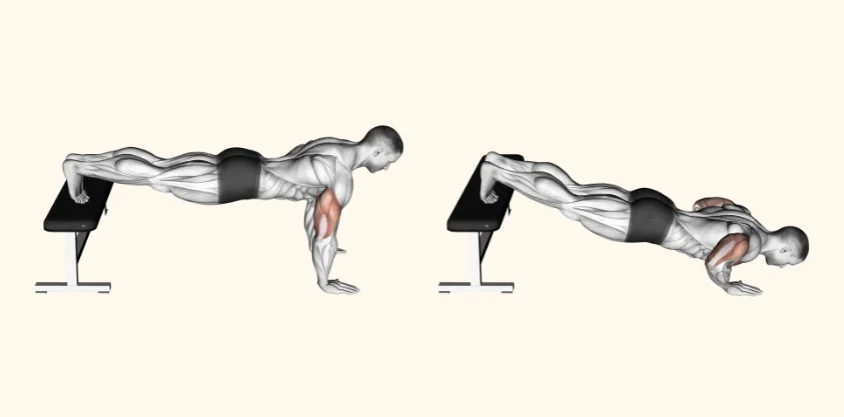
How to Perform:
- Place your feet on an elevated surface such as a bench or step, with your hands on the ground shoulder-width apart.
- Perform a push-up from this declined position.
Why It Works:
- The decline increases the load on the upper chest and shoulders, indirectly increasing the engagement of the biceps as stabilizers.
5. One-Arm Push-Ups
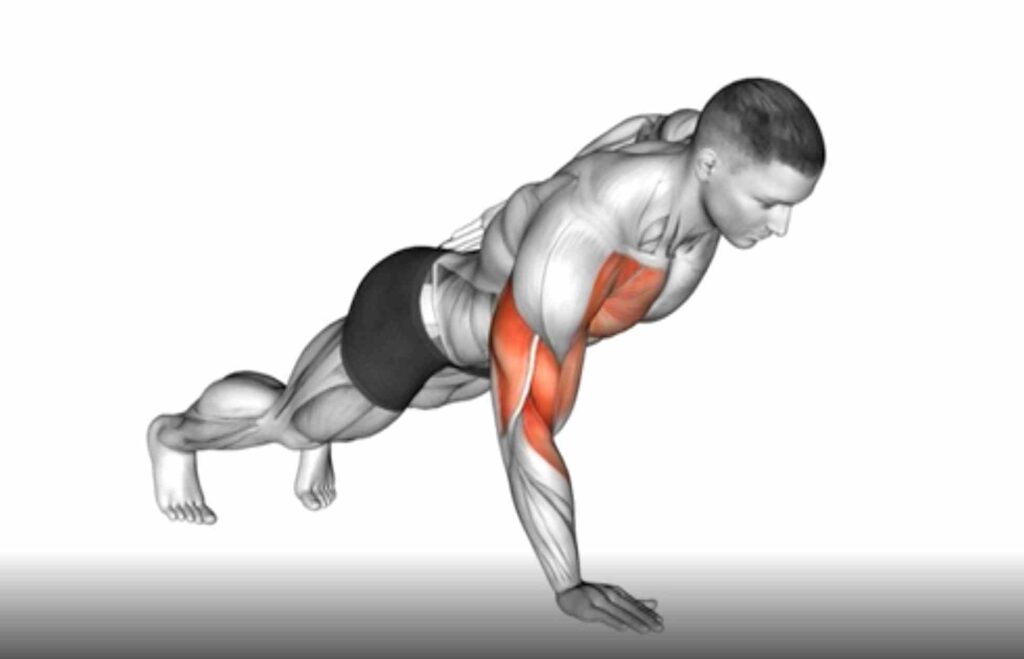
Best Curl Variation for Biceps
How to Perform:
- Start in a standard push-up position.
- Place one hand behind your back or out to the side.
- Lower your body with the supporting arm, then push back up.
Why It Works:
- This variation demands significant stabilization from the biceps on the supporting arm to maintain balance and control.
6. Archer Push-Ups
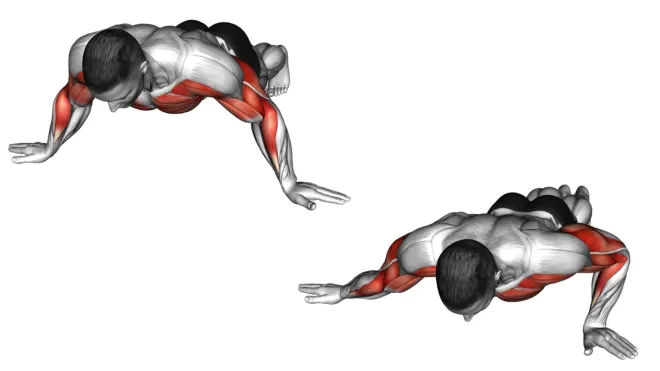
How to Perform:
- Begin in a wide-stance push-up position.
- Lower your body towards one hand, extending the opposite arm straight out to the side.
- Push back up and repeat on the other side.
Why It Works:
- This asymmetrical movement places more load on the working arm, including the biceps, as you lower and push up.
7. Spiderman Push-Ups

How to Perform:
- Start in a standard push-up position.
- As you lower your body, bring one knee towards the elbow on the same side.
- Push back up and return the leg to the starting position, then switch sides.
Why It Works:
- This variation adds an element of core stability, which indirectly increases the engagement of the biceps and other arm muscles.
Tips for Maximizing Bicep Engagement
- Slow Down the Movement: Performing push-ups slowly can increase muscle tension time, enhancing muscle activation.
- Focus on Form: Ensure proper form to maximize the effectiveness of each variation and prevent injury.
- Combine Variations: Incorporate different variations into your routine to target the biceps from various angles and keep workouts challenging.
Does Weightlifting Decrease Flexibility?
By including these variations in your workout routine, you can more effectively target the biceps, alongside the primary muscles worked by push-ups. Remember to balance these exercises with other movements to ensure comprehensive arm development.
Do Push-ups Work Biceps?
Yes, push-ups do work the biceps, although they are not the primary muscle targeted by this exercise. Push-ups are primarily known for strengthening the chest (pectorals), triceps, and shoulders (deltoids). However, the biceps also play a supportive role, particularly in stabilizing the elbow joint and controlling the downward phase of the movement.
While the biceps activation in push-ups is less intense compared to exercises that directly target them, such as bicep curls, certain push-up variations like close-grip (diamond) push-ups, reverse grip push-ups, and pike push-ups can increase biceps engagement. Incorporating these variations into your routine can help ensure that your biceps receive a secondary workout, contributing to overall arm strength and muscular balance.
Exercises for Biceps
Here are some exercises that can help strengthen and build your biceps:
Exercises for Long and Short-Head Biceps
1. Barbell Curl
This exercise engages both the short and long heads of the biceps. You can alter the grip width to slightly change the emphasis.
How to Perform: Stand up straight with a barbell in your hands at shoulder-width. Keep your elbows close to your torso. Now, curl the weights while contracting your biceps as you breathe out. Tip: Only the forearms should move.
Sets & Reps: 3 sets of 8-10 reps
2. Hammer Curl
Hammer curls target the long head of the biceps as well as the brachialis, a muscle of the upper arm.
How to Perform: Stand up with your torso upright and a dumbbell in each hand at arm’s length. The elbows should be close to the torso. The palms of the hands should be facing your torso. Now, while holding the upper arm stationary, curl the weights while contracting your biceps as you breathe out.
Sets & Reps: 3 sets of 8-10 reps
3. Concentration Curl
Concentration curls isolate the biceps, putting the focus of the work on the biceps alone. This can lead to increased size and strength.
How to Perform: Sit on a flat bench with one dumbbell in front of you between your legs. Your legs should be spread with your knees bent and feet on the floor. Use your right arm to pick up the dumbbell. Place the back of your right upper arm on the top of your inner right thigh. Curl the weights while contracting your biceps as you breathe out. Only the forearms should move.
Sets & Reps: 3 sets of 10-12 reps
4. Chin-Up
Chin-ups are a compound exercise that primarily targets your back, but they also work the biceps.
How to Perform: Grab the pull-up bar with the palms facing your torso and a grip closer than the shoulder width. As you have both arms extended in front of you holding the bar, bring your torso back around 30 degrees while creating a curvature on your lower back and sticking your chest out. Pull your torso up until the bar touches your upper chest by drawing the shoulders and the upper arms down and back. Tip: Concentrate on squeezing the back muscles once you reach the full contracted position.
Sets & Reps: 3 sets of 6-8 reps
5. Zottman Curl
Zottman curls are a twist on traditional curls that target both the biceps and the forearms. They involve a rotation of the wrists partway through the movement.
How to Perform: Stand with a dumbbell in each hand, arms fully extended, and palms facing your torso. Keep your elbows close to your torso at all times. Curl the weights while contracting your biceps as you breathe out. At the top of the movement, rotate your wrists until your palms are facing down. Lower the dumbbells back down, then rotate your wrists back to the starting position.
Sets & Reps: 3 sets of 8-10 reps
6. Incline Dumbbell Curl
Incline dumbbell curls are a bicep curl variation that helps to lengthen the biceps muscle and increase the stretch and contraction.
How to Perform: Sit back on an incline bench with a dumbbell in each hand held at arm’s length. Keep your elbows close to your torso. Rotate the palms of your hands until they are facing forward. Now, while holding the upper arm stationary, curl the weights while contracting your biceps as you breathe out. Only the forearms should move.
Sets & Reps: 3 sets of 10-12 reps
By incorporating these exercises into your fitness routine, you can effectively target and develop your biceps for stronger, more defined arms.
Importance of a Balanced Workout Routine
A balanced workout routine is crucial for overall health and fitness. Here’s why:
- Full Body Development: Focusing on only one muscle group can lead to imbalances in your body. A balanced routine ensures all muscle groups are worked evenly, promoting proportional muscle growth and overall body symmetry.
- Injury Prevention: Overworking one muscle group while neglecting others can lead to imbalances that increase the risk of injury. A balanced routine helps prevent this by ensuring no muscle group is overstrained or underworked.
- Improved Performance: Training all muscle groups improves overall body strength and functionality. This can enhance performance in physical activities and daily tasks.
- Promotes Cardiovascular Health: Incorporating both strength training and cardio exercises in your routine not only builds muscle but also improves heart health.
- Flexibility and Balance: Including stretching and balance exercises in your routine can improve joint flexibility, coordination, and reduce the risk of falls.
- Prevents Workout Plateau: Varying your workouts challenges your body in different ways, helping to prevent plateaus and maintain progress.
- Mental Health Benefits: A balanced routine includes exercises for stress relief and mental well-being, such as yoga or meditation.
Can Exercise Reduce Cellulite?
Remember, it’s important to tailor your workout routine to your individual fitness goals and needs.
Common Mistakes
Here are some common form mistakes that can reduce the effectiveness of push-ups;
1. Sagging Hips
- Mistake: Letting the hips droop towards the floor, which can strain the lower back and reduce core engagement.
- Correction: Keep your body in a straight line from head to heels. Engage your core by tightening your abdominal muscles and glutes to maintain proper alignment.
2. Raised Hips
- Mistake: Keeping the hips too high, which reduces the effectiveness of the exercise on the chest and shoulders.
- Correction: Ensure your body forms a straight line. Lower your hips to align with your shoulders and heels, maintaining a plank position throughout the movement.
3. Flared Elbows
- Mistake: Allowing the elbows to flare out to the sides, which can put unnecessary stress on the shoulders.
- Correction: Keep your elbows at a 45-degree angle to your body. Tuck them in slightly towards your ribs to protect your shoulders and engage your triceps more effectively.
4. Incomplete Range of Motion
- Mistake: Not lowering your body all the way down or not pushing all the way up, which limits muscle engagement and effectiveness.
- Correction: Lower your body until your chest nearly touches the floor and fully extend your arms at the top of the movement. Focus on maintaining a full range of motion to maximize benefits.
5. Head Position
- Mistake: Dropping or craning the head, which can strain the neck and disrupt body alignment.
- Correction: Keep your head in a neutral position, looking slightly ahead of you. Your neck should stay in line with your spine throughout the exercise.
6. Hand Placement
- Mistake: Placing hands too far forward or too wide, which can reduce stability and effectiveness.
- Correction: Position your hands shoulder-width apart directly under your shoulders. Ensure your fingers are spread out and gripping the floor for better stability.
7. Poor Breathing Technique
- Mistake: Holding your breath during push-ups, which can reduce performance and increase fatigue.
- Correction: Breathe in as you lower your body and exhale as you push up. Maintaining a steady breathing rhythm helps keep you energized and focused.
By avoiding these common mistakes and following proper technique, you can maximize the effectiveness of push-ups and reduce the risk of injury.
FAQs
Q 1. Can beginners use push-ups to build biceps?
Ans. Yes, beginners can use push-ups, especially variations like close-grip push-ups, to help engage the biceps. However, for optimal bicep growth, incorporating bicep-specific exercises is recommended.
Q 2. How many push-ups should I do to see bicep growth?
Ans. There isn’t a one-size-fits-all answer, as it depends on individual fitness levels. Generally, aim for 3 sets of 10-15 reps of push-up variations that target the biceps. Gradually increase the reps as you get stronger.
Q 3. Will doing push-ups every day help build my biceps?
Ans. Daily push-ups can contribute to overall upper body strength, including the biceps, but it’s important to allow muscles to rest and recover. Aim for 3-4 times a week and include rest days for optimal muscle growth.
Q 4. Are weighted push-ups more effective for bicep growth?
Ans. Weighted push-ups can increase overall muscle engagement and strength, including the biceps. However, they primarily still target the chest, shoulders, and triceps. Combine with bicep-specific exercises for best results.
Q 5. How does hand placement affect bicep activation in push-ups?
Ans. Closer hand placements, such as in diamond or close-grip push-ups, increase the engagement of the biceps compared to wider hand placements.
Q 6. How long does it take to see noticeable bicep growth from push-ups?
Ans. Visible bicep growth varies by individual. With consistent effort and proper form, you might start seeing results in a few weeks to a couple of months, depending on your overall fitness routine and diet.
Conclusion
In conclusion, while push-ups primarily target the chest, shoulders, and triceps, they also engage the biceps as stabilizers. While push-ups alone may not be sufficient for significant bicep growth compared to dedicated bicep exercises like curls, incorporating variations that emphasize bicep engagement can still contribute to overall upper body strength and development. Push-ups offer a convenient and versatile way to improve upper body strength, endurance, and stability, making them a valuable addition to any workout routine.
Whether aiming for muscle growth, improved fitness, or functional strength, integrating push-ups alongside targeted bicep exercises can help achieve well-rounded upper body development. Experimenting with different push-up variations and maintaining proper form will maximize bicep activation while reaping the numerous benefits that push-ups offer for overall fitness.

Good day, and welcome to Fitthour. My name is Shubham Vijay, and I am a certified personal trainer and nutrition coach with 6 years of experience in the fitness industry. At Fitthour, we specialize in types of training, such as strength training, cardio, or HIIT, and our mission is to help clients achieve their fitness goals and improve their overall health.

